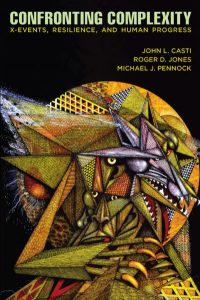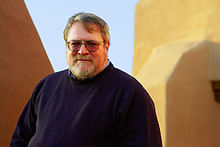Confronting Complexity: X-Events, Resilience, and Human Progress
by John L. Casti, Roger D. Jones, Michael J. Pennock
Brief
The book you are seeing on your screen may look like a normal book; it is not. It is a conversation in which you are a participant. The book does not offer pat answers to hard questions. In fact, it barely even gives definition to hard questions. Rather, this book presents that stage in which science is most challenging and, arguably, most interesting—the period of identifying just what the problems and issues are. That is why we solicit your help in writing this story—the story of extreme events in social systems.
The participants in this book-writing enterprise are independent thinkers who wish to understand the forces impinging on social systems and the systems’ often dramatic and extreme responses to those forces. Extreme events, the sudden and discontinuous response of social systems to these forces, are what we for shorthand term X-Events. X-events We imagine the reader to be a person who wants to intelligently manage his or her actions and behaviors in the midst of an X-event—in short, to manage an organization in chaos. And not only manage, but be a beneficiary of that event. Explicitly, we understand that there are no simple answers to social questions. But but there is at least a gestalt that can help an individual anticipate and manage X-events. The program outlined here is to build the gestalt by total immersion in the topic—by examining the issues from many perspectives.
Here we look at X-events from the following points of view or frames of reference:
- case studies
- mythology
- academic sociology
- natural analogs
- English literature
- engineering risk management
- mathematical modeling
No one perspective is sufficient to capture the entire picture. But patterns begin to emerge when questions are asked from several points of view. What seems to be emerging is that X-events are a fundamental property of social systems, and that if human progress is to be made it depends intimately on X-events for propelling it forward.
TABLE OF CONTENTS

TABLE OF CONTENTS
PREFACE 13
ACKNOWLEDGMENTS 15
- HERE IN THE REAL WORLD 17
- It Came from Outer Space 18
- Cancelling Armageddon 21
- Exercises: Potential Energy 22
- Just a Little Shove 23
- Exercises: Kinetic Energy 25
- Don’t Blow Your Top 25
- Exercises: Internal Energy 28
- Exercises: Power and Energy Flux 29
- Not-So-Extreme Events 29
- The Context and the Trigger 31
- Complexity Gaps 33
- Exercises: Complexity Measurement 36
- Exercises: Complexity of Social Mood 38
- Social Mood 39
- Exercises: Is Shannon Entropy Right? 44
- Measuring Social Mood 46
- US Presidential Elections and Social Mood 47
- Exercises: Systems 49
- Resilience: The Good, the Bad, and the Absolutely Essential 50
- Hurricanes as Complexity Metaphors 56
- Scientifically Accurate Poetry 57
- Spiral of Complexity 58
- Thermal Conduction 59
- Emergence of Order: Rayleigh-Bénard Instability 60
- Sudden Complexity Shifts 61
- Hadley, Ferrel, and Polar Cells 61
- Effect of Earth’s Rotation 63
- Sudden Creation of Hurricanes 65
- But . . . Hurricanes Rotate in the Wrong Direction 66
- Heat Transfer to the Poles 66
- Discussion and Research Questions 71
- Extreme Value Theory 71
- Feedback 72
- Extreme Value Theory Redux 73
- Undulating Landscape 75
- Feedback and Social Mood 76
- Resilience of Social Systems 77
- It Came from Outer Space 18
- DRIVERS OF CHANGE 81
- Trends and Transitions 82
- Ferguson’s Drivers of Historical Change 83
- Five Stages of Collapse 85
- Mood and Complexity as Leading Drivers 87
- Discussion Questions: Complexity Mismatch and Mood 100
- Why Is the Trend “Normal” Behavior? 100
- Why Is It Difficult to Assign a Probability to an X-event? 101
- Is Social Mood an Aggregation of Everyone’s Subjective Probability of the Future? 102
- How Does Herding Affect Social Mood? 102
- Why Are Shifts in the Trend a Surprise? 104
- Shifts in Social Mood Are Different in Going from Optimistic to Pessimistic Than Pessimistic to Optimistic 105
- Demographic Transition 106
- What Do We Mean By a Model? 107
- Irrigation System: Flows 109
- Irrigation System: Distribution of Water 113
- Irrigation System: System Behavior 115
- Irrigation System: Controlling the Flow of Water 116
- Irrigation System: Dynamics of the Irrigation System 117
- Exercises: Dynamics of the Irrigation System 119
- Hey! . . . What About Women’s Education and Economic Drivers of Fertility? 119
- Effects of Controller Responsiveness 120
- Core Model 122
- Vital Demographic Variables 124
- Statics of the Demographic Transition 127
- Clustering of World Populations 128
- Dynamics of the Demographic Transition 131
- Exercises: Population Explosion 133
- Discussion Questions: Population Explosion 134
- Exercises: Demographic Transition 135
- Discussion Questions: Demographic Transition 139
- Exercises: Aging and Economics 142
- Trends and Transitions 82
- UP CLOSE AND PERSONAL 147
- The One and the Many 148
- Exercise: X-Events at the Personal Level 150
- Discussion Question: Ashby’s Law 150
- Discussion Question: Hamlet 150
- “Middle” Crises 153
- Discussion Question: Hero’s Journey 156
- Stages of the Journey 157
- Inequality Kills Everything 158
- Discussion Questions: Productivity, Income Inequality, and the Jobless Recovery 165
- Productivity 165
- Income Inequality 166
- The Jobless Economic Recovery 167
- Polarization and Social Mood 168
- Examples: Stable States 169
- Examples: Mixing of Optimists and Pessimists 170
- Examples: Competition Between Uniform and Mixed Domains 172
- Discussion Question: Red Counties and Blue Counties 172
- Te Model 173
- Simulation Results 174
- Fixed Points of the System 174
- Fixed Points Solutions 175
- Exercise: Character of Fixed Points 177
- Stability of Fixed Points 177
- Exercises: Modeling Inequality 179
- Discussion Questions: Personal X-Events 179
- Bipolar Disorder 180
- Nature vs. Nurture 180
- Evidence-Based Beliefs 181
- Changing Religious Demographics in the United States 181
- Discussion Questions: Political X-Events 182
- Political Leaders 182
- Social Mood and the 2014 US Midterm Election 183
- Texas Politics 184
- Discussion Questions: Utility 186
- Risk Aversion 187
- Prospect Theory 187
- Probability Adjustment 188
- The One and the Many 148
- STAYIN’ ALIVE 191
- Time for a Change 192
- Failure is Always An Option 193
- Out of the Ashes 197
- Discussion Question: Bailouts 198
- Mirror Vision and Complexity Overload 199
- Discussion Question: Swiss-Cheese Model 201
- Over the Edge of the Technology Cliff 201
- Exercises: Complexity Mismatch in Business and Politics 202
- How Mood Affects the Nature of Products 203
- Commodities 204
- Risk in Commodity Production 204
- Product Quality 205
- Mood and Compound Products 205
- Meta-Products 206
- Discussion Questions: Risk, Mood, and Commodities 207
- How Stability of Companies Leads to Instability of Companies 208
- Stability and Middle Management 208
- Negative Feedback 209
- Te Example of Kodak 210
- Discussion Questions: Stability of Companies 211
- Discussion Questions: Photography and Visual Arts 212
- The Beer Game 212
- Te Beer Supply Chain 213
- Playing the Beer Game Live 213
- Stable Operation of the Live Beer Game 216
- Simulation of the Beer Game 217
- Simulation Parameters and Contextual Drivers 218
- Analysis of a Beer Game Simulation with Variable Chain Length 219
- Discussion Question: Communication Delay 223
- Exercises: The Beer Game 223
- Discussion Questions: The Beer Game 224
- The Business of US Healthcare 224
- US Healthcare is Poised for an X-Event 225
- Why is Healthcare Not a Commodity? 227
- Two Visions 229
- Discussion Question: Physician Compensation 231
- Technology-Driven Complexity Mismatch 232
- Patents Affect Complexity Mismatch 234
- Regulation of the Pharmaceutical Industry 235
- Discussion Question: Forces on the Pharmaceutical Industry 237
- Personalized Medicine and Information Management for Treatment 238
- Personalized Medicine and Clinical Trials 241
- Insurance-Driven Healthcare Cost Inflation 242
- Discussion Question: Employer-Funded Insurance 243
- Discussion Question: Affordable Care Act of 2010 244
- Discussion Question: Complexity, Mood, and Random Triggers in Healthcare 244
- Discussion and Research Questions 245
- EXPECTING THE UNKNOWN UNKNOWNS 251
- The Resilience of “Resilience” 252
- Discussion Question: Resilience on All Scales 255
- Resilient Against What? 255
- Exercise: Insurance World 261
- Planning for the Unimaginable 261
- Discussion Question: Oregon Healthcare 265
- How Resilient Are You? 265
- Exercise: Measuring the Four As 267
- Climate Change: An Example of Managing the Four As 267
- Building on the Hurricane Example 268
- Beliefs and Mood on Climate Change 269
- Climate Change: Awareness 269
- Is the Climate Warming? 272
- Discussion Question: Measuring Ancient Temperatures 273
- How Do Scientists Know That Recent Climate Change Is Caused by Human Activities? 273
- Discussion Question: CO2 275
- CO2 Is Already in the Atmosphere Naturally, so Why Are Emissions from Human Activity Significant? 276
- Discussion Question: Hydrocarbons and Much More 277
- What Role Has the Sun Played in Climate Change in Recent Decades? 278
- Exercises: Sunspot Cycle 279
- Climate Is Always Changing. Why Is Climate Change of Concern Now? 280
- Exercise: Ice Ages 280
- Discussion Question: Time Scales 281
- Is the Current Level of CO2 Concentration Unprecedented in Earth’s History? 281
- Is There a Point at Which Adding More CO2 Will Not Cause Further Warming? 282
- Exercise: Absorption Bands 282
- Does the Rate of Warming Vary from One Decade to Another? 282
- Exercise: Modulations 283
- Discussion Question: Frogs in a Pot 283
- Does the Recent Slowdown of Warming Mean That Climate Change Is No Longer Happening? 284
- Exercise: Warming Over the Last Decade 284
- If the World is Warming, Why Are Some Winters and Summers Still Very Cold? 285
- Discussion Question: Second Law of Thermodynamics 285
- Exercise: Autocatalytic Reactions 286
- Why Is Arctic Sea Ice Decreasing While Antarctic Sea Ice Is Not? 287
- Exercise: Ice Melt in the Antarctic 287
- How Does Climate Change Affect the Strength and Frequency of Floods, Droughts, Hurricanes, and Tornadoes? 288
- How Fast Is Sea Level Rising? 288
- Exercise: Florida 289
- What Is Ocean Acidification and Why Does It Matter? 289
- How Confident Are Scientists That Earth Will Warm Further over the Coming Century? 290
- Discussion Question: There Is Time, but So What? 290
- Are Climate Changes of a Few Degrees a Cause for Concern? 291
- What Are Scientists Doing to Address Key Uncertainties in Our Understanding of the Climate System? 291
- Are Disaster Scenarios about Tipping Points Like ‘Turning of the Gulf Stream’ and Release of Methane from the Arctic a Cause for Concern? 292
- If Emissions of Greenhouse Gases Weretopped, would the Climate Return to the Conditions of 200 Years Ago? 292
- What About Other X-Events Simultaneous to Climate Change? 293
- Climate Change: Assimilation 293
- Discussion Question: How Bad Is It Likely To Be? 294
- Discussion Question: How Do We Identify Our Options for Survival? 295
- Discussion Question: How Do We Evaluate Our Options for Survival? 295
- Discussion Question: How Do We Implement Our Options for Survival? 296
- Climate Change: Agility 297
- Discussion Question: What are the Opportunities That Might Arise? 297
- Discussion Question: What Resources Do We Have to Take Advantage of the Opportunities? 298
- Climate Change: Adaptively 298
- Discussion Question: Venice, Italy 299
- Discussion Question: Punctuated Equilibrium 300
- Discussion Question: Human Progress 301
- Discussion Question: Path Dependence 302
- Discussion Question: Simulation 303
- Discussion Question: Controlled X-Events 304
- The Burkian Game 305
- Connections 305
- Germ Theory of Disease 307
- Childhood Deaths and Fertility 308
- Economic Response 309
- Climate Change 310
- Discussion Question: Are Human Brains Big Enough? 311
- The Resilience of “Resilience” 252
INDEX 313
ABOUT THE AUTHORS










